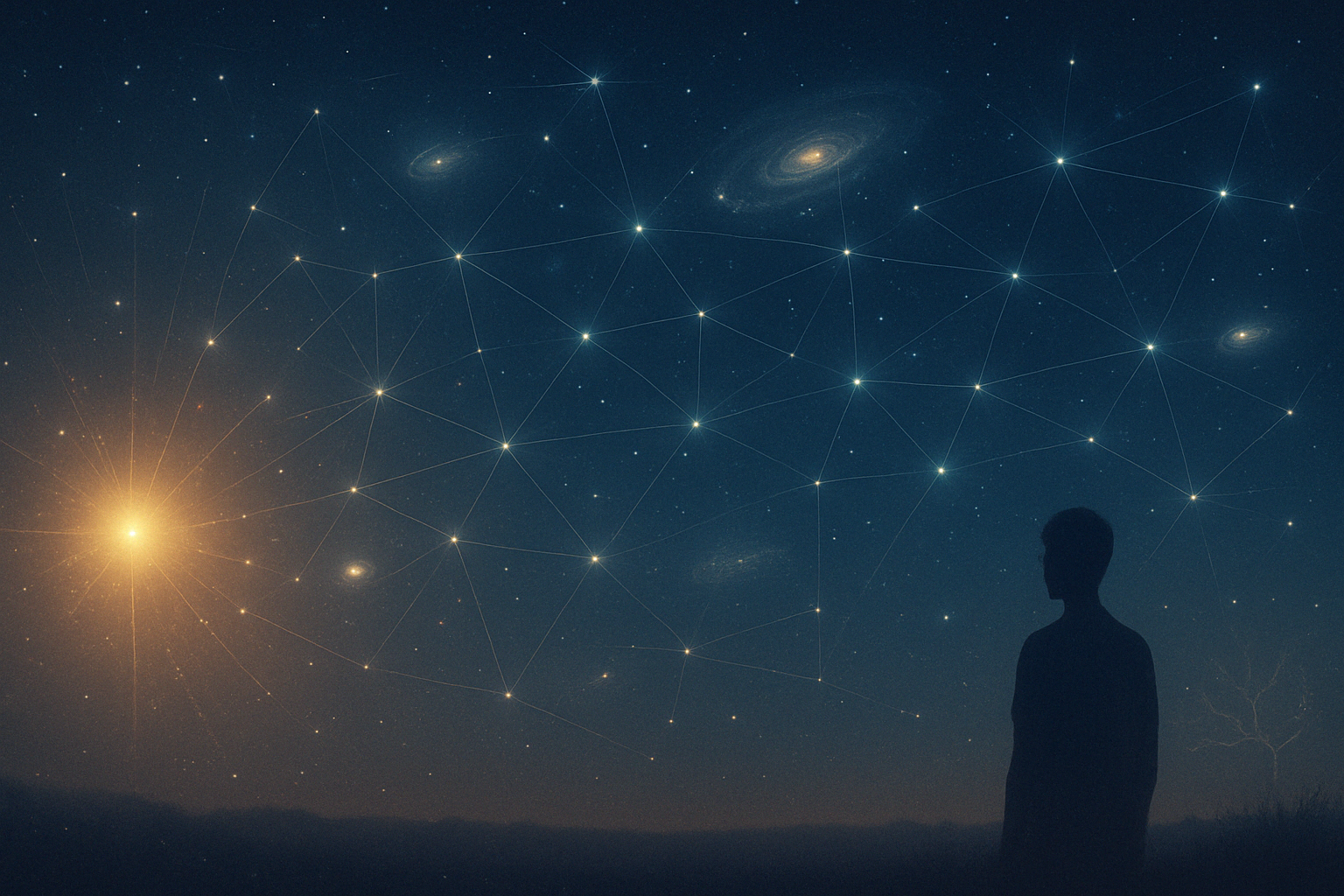Physics
How does the universe relate?

The laws of the universe are the rhythms of relationship.
Relational Physics
In Relatism, physics is not the study of isolated objects, but of relationships. Matter, force, space, and time are not independent absolutes — they are emergent from the way things relate. Every property we observe is meaningful only in the context of interaction.
Time and Asymmetry
Time, in a Relatist frame, is not a container we move through but a relational consequence of change. The arrow of time reflects the asymmetry in how relationships evolve — entropy grows, systems unfold, coherence disperses or deepens.
From this view, the Big Bang is not merely the origin of energy and matter, but the moment when pure simultaneity gave way to the possibility of independence — and therefore, of relationship.
From Simultaneity to Independence
At the beginning, all things were one — a singular, relational simultaneity. As the universe expanded, the conditions for relational distinction emerged. Time began when relationships could no longer occur all at once. The cosmos became a field of independent agents in dynamic relation.
Quantum Relationality
Quantum physics reveals that particles do not possess definite properties until measured. Entanglement shows that particles share a state that transcends distance. The observer effect indicates that measurement itself is a form of relation.
Relatism interprets these not as paradoxes but as evidence that the physical world is fundamentally relational — coherence and interaction precede definition.
Fields and Forces as Relationship
Gravitational, electromagnetic, and nuclear forces are descriptions of stable, recursive relationships. A field is not a thing in itself, but a structured pattern of potential relation — a coherence extended through space and time.
Relatism and Classical Physics
Classical physics seeks to describe the behavior of isolated objects in deterministic systems. Relatism shifts the emphasis toward interaction: properties arise from context, and outcomes are shaped by relational structure rather than inherent essence.
Where classical models focus on forces and trajectories, Relatism foregrounds coherence, recursion, and emergence. A Relatist model may describe a system not just by predicting its motion, but by evaluating the strength and structure of its relationships over time.
Adjusting Modern Theories
Relatism invites reinterpretation of many foundational theories:
- General Relativity: Space-time curvature is not merely geometry, but the shape of relationships among masses — the way coherence reshapes context.
- Quantum Mechanics: Wavefunction collapse is not randomness but resolution — the stabilization of relation through interaction.
- Thermodynamics: Entropy reflects not just disorder, but relational complexity — a measure of the shifting distribution of coherence.
Implications
- Time and space are not fixed stages, but emergent from evolving relationships.
- Measurement is not neutral — it is a relational act that transforms what is observed.
- The universe is not made of things, but of patterns — relationships unfolding recursively.
- Consciousness may be the highest expression of relational coherence — not beyond physics, but deeply within it.
Relatism does not discard existing physics — it reframes it. It calls us to look beyond substance, beyond force, to the dynamic, recursive relationships that give rise to everything we know.
Dark Matter and Relational Incompleteness
Dark matter is inferred through its gravitational effects, yet it remains invisible and unmeasured directly. In Relatism, this could represent an incomplete view of relational coherence. What we call “dark” may not be a separate substance but an expression of relationships not yet accounted for in our models. Gravity, in this view, is not a force between objects, but a persistent relational structure that can exist even if its participants are not fully understood.
Dark Energy and Relational Drift
Dark energy is posited to explain the accelerating expansion of the universe. Rather than a mysterious repulsive force, Relatism interprets this as a shift in the density of relationships across the cosmos. As coherent structures become more independent, the fabric of space expands — not due to pressure, but as a reflection of declining relational proximity.
Universal Expansion as Relational Evolution
Expansion may not be emptiness increasing, but opportunity expanding — space for new relational structures to emerge. Galaxies and superclusters can be viewed not merely as matter collections, but as coherent nodes in an evolving network. The universe itself may be undergoing a recursive deepening — forming new layers of coherence through greater degrees of independence and complexity.
Closing Reflections
These are some of the questions that Relatism throws into the mix as we deepen our understanding of the cosmos. It does not seek to replace physics, but to reframe it — to explore what changes when we shift from asking “What is the universe made of?” to “How does the universe relate?”
Relatism offers a coherent lens through which to view the fundamental processes that structure our universe: not as disconnected forces and particles, but as recursive, relational events giving rise to emergent coherence — from particles to people to the cosmos itself.